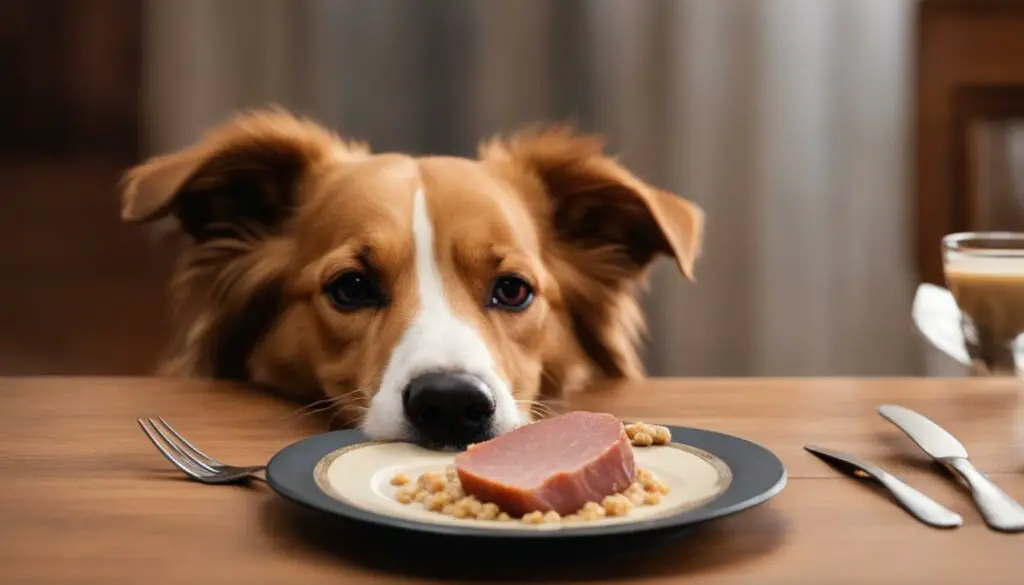As a responsible pet owner, it’s crucial to know which foods are safe for your furry friend. One common question that arises is whether dogs can eat ham bones. In this article, I will delve into this topic to help you make informed decisions about your dog’s diet.
Dogs have different dietary needs and digestive systems compared to humans. While there are certain foods that dogs can consume in moderation, it’s essential to understand the potential risks associated with certain foods, including ham bones.
Feeding your dog a ham bone may seem harmless, but it can actually pose several dangers to their health. Ham bones can splinter easily, causing potential injuries to the digestive system or choking hazards. These splintered bones can also wreak havoc on your dog’s teeth and gums. It’s crucial to prioritize your pet’s safety and well-being by offering safe alternatives.
Later in this article, I will explore the risks of feeding ham bones to dogs in more detail, discuss alternative bone options, and provide valuable insights into canine nutrition and bone health. By the end, you’ll have a better understanding of what’s best for your furry friend.
Key Takeaways:
- Feeding ham bones to dogs can be dangerous, as they can splinter easily and cause digestive issues or choking hazards.
- It’s important to choose dog-friendly bone options that are specifically designed to be safe for dogs to chew on.
- Dogs have different digestive systems compared to humans, and certain foods that are safe for us may be harmful to them.
- There are various safe alternatives to feeding ham bones, such as dog-friendly bones that promote dental health and satisfy your dog’s chewing needs.
- Proper nutrition is crucial for dogs, and it’s important to consult with a veterinarian to ensure your dog’s diet meets their specific needs.
The Risks of Feeding Ham Bones to Dogs
Feeding ham bones to dogs can pose several risks. One of the main concerns is that ham bones can splinter easily, which can lead to potential injuries to the dog’s digestive system or choking hazards. The splintered bones can also cause damage to the dog’s teeth and gums, resulting in pain and discomfort. This is why it is important to be cautious when giving your dog any type of bone to chew on.
There are dog-friendly bone options available in the market that are specifically designed to be safe for dogs to chew on. These bones are typically made of materials that are less likely to splinter, reducing the risk of harm to the dog. It is important to choose these safer alternatives to ensure the well-being of your furry friend.
Remember, the safety of your dog should always be a priority. Consult with your veterinarian for guidance on the best bone options for your dog’s specific needs and breed. By being aware of the risks associated with feeding ham bones and making informed choices, you can keep your dog safe and happy.
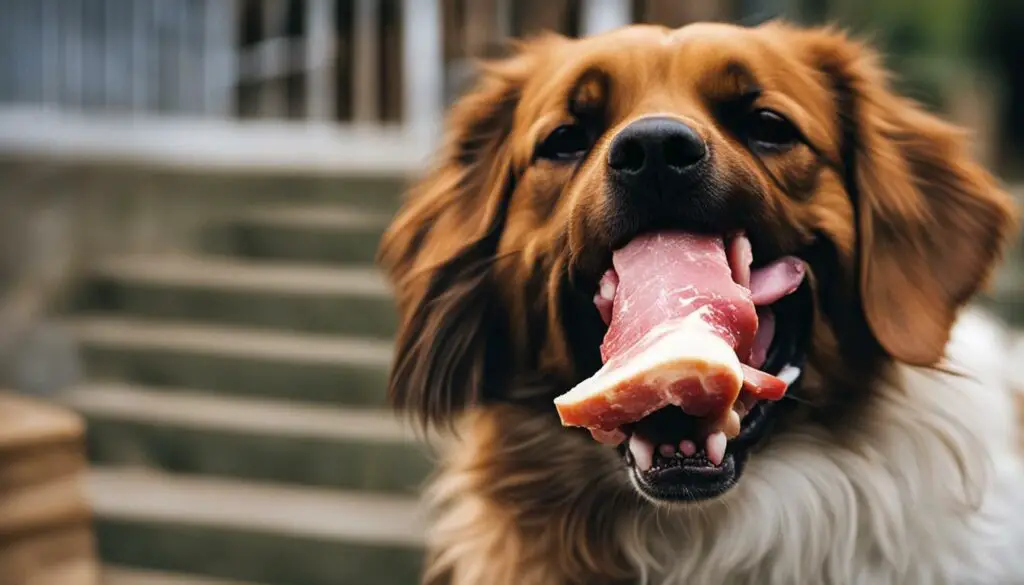
| Risks of Feeding Ham Bones to Dogs | Precautions |
|---|---|
| Splintering of bones | Choose dog-friendly bone options that are less likely to splinter. |
| Injuries to the digestive system | Avoid feeding ham bones to dogs to prevent potential injuries or blockages. |
| Choking hazards | Be cautious when giving any type of bone to your dog and supervise them while they chew. |
| Dental damage | Ham bones can cause damage to the dog’s teeth and gums, leading to pain and discomfort. |
Understanding the Dog’s Digestive System
When it comes to feeding our furry friends, it’s important to understand their unique digestive system. Dogs have different digestive systems compared to humans, which means some foods that are safe for us may be potentially hazardous for them. Feeding ham bones to dogs can pose potential hazards to their digestive system and overall health.
The dog’s digestive system is designed to handle certain types of food. While dogs have a strong jaw and sharp teeth that may lead us to believe they can handle bones, ham bones in particular can cause issues. These bones can splinter easily, leading to injuries in the dog’s digestive system or even pose a choking hazard. The splintered bones can also cause damage to the dog’s teeth and gums.
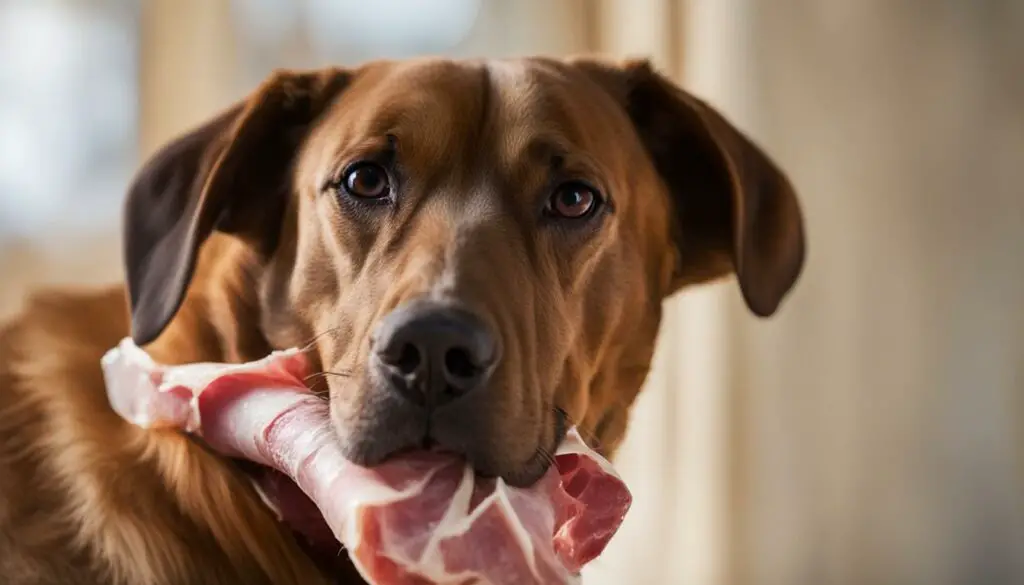
It’s essential to be aware of these potential hazards and choose alternative bone options that are safer for dogs to consume. By understanding the dog’s digestive system and making responsible choices, we can ensure the well-being of our beloved pets.
Alternatives to Feeding Ham Bones
Feeding ham bones to dogs can have potential risks and hazards. To ensure the safety and well-being of your furry friend, it’s best to provide alternative bone options that are specifically designed for dogs. These dog-friendly bone options are a safer choice as they are less likely to splinter, which can cause injuries and digestive issues in dogs.
When choosing alternative bones for your dog, it’s important to consider the proper bone size based on your dog’s breed and chewing habits. Providing the right-sized bone helps prevent choking hazards and tooth breakage. There are various sizes available in the market, so you can find the perfect fit for your canine companion.
Additionally, these dog-friendly bone options provide a satisfying chewing experience for your dog while promoting dental health and satisfying their natural urge to chew. They come in different flavors and textures, making them irresistible for your four-legged friend. Offering safe alternatives to ham bones ensures that your dog can enjoy a healthy and enjoyable chewing experience without compromising their health.
Remember, consulting with a veterinarian is always advisable when it comes to your dog’s nutrition and overall well-being. They can provide guidance on the best bone options for your dog based on their specific needs. By prioritizing the safety of your dog and providing suitable alternatives, you can ensure that they have a happy and healthy life.
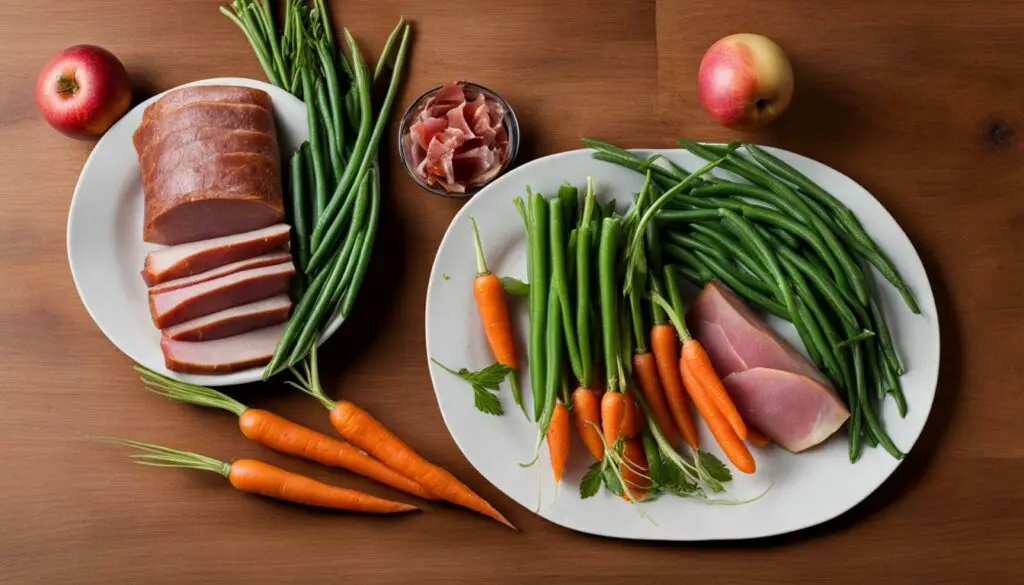
Canine Nutrition and Bones
Proper nutrition plays a vital role in maintaining the health and well-being of our canine companions. When it comes to bones, it’s essential to choose the right options that are both safe and nutritious for dogs. While there are certain bones that dogs should avoid, such as ham bones, there are also dog-friendly bone options that can provide numerous benefits. These bones are specifically designed to meet a dog’s chewing needs without posing the risks associated with splintering or choking.
Dog-friendly bone options promote not only dental health but also provide essential minerals and contribute to a dog’s overall nutrition. Chewing on bones can help remove plaque and tartar from their teeth, reducing the risk of dental diseases. Furthermore, bones can fulfill a dog’s natural urge to chew, providing mental stimulation and emotional satisfaction.
Benefits of Dog-Friendly Bone Options:
- Support dental health by reducing plaque and tartar buildup
- Provide essential minerals, such as calcium, for strong bones and teeth
- Offer mental and emotional stimulation through natural chewing behaviors
- Promote healthy jaw and muscle development
- Contribute to a balanced diet and overall nutrition
Choosing the right-sized bone for your dog is crucial to ensure their safety and enjoyment. Consider factors such as the size, breed, and chewing habits of your dog when selecting dog-friendly bones. It’s always best to consult with your veterinarian to determine the most appropriate bone options for your furry friend. By prioritizing canine nutrition and opting for safe bone alternatives, you can provide your dog with a healthy and satisfying chewing experience.
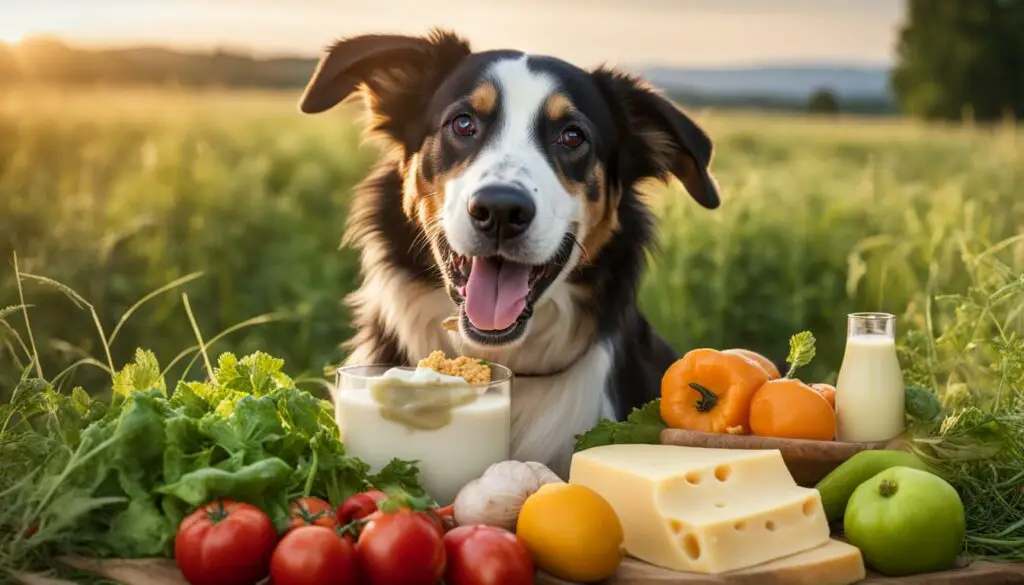
Misconceptions About Feeding Dogs Certain Human Foods
There are several misconceptions surrounding the feeding of human foods to dogs. Let’s address some of them to provide accurate information to pet owners. One common misconception is about apple cores and seeds. While it’s important to remove the cores and seeds to prevent any potential poisoning, eating a few apple seeds is unlikely to cause harm to dogs. However, it’s always best to err on the side of caution and avoid feeding apple seeds to dogs to ensure their safety.
Another misconception is about pork. Contrary to popular belief, pork is safe for dogs to consume as long as it is cooked properly and does not contain any added seasonings. Cooked pork can be a tasty and nutritious treat for your furry friend. Just make sure to remove any excess fat or bones before feeding it to them.
Similarly, there is a misconception that grains are harmful to dogs. While some dogs may have allergies or sensitivities to grains, they are not inherently harmful. In fact, grains can provide valuable nutrients and fiber to a dog’s diet, as long as they are not sensitive to them. It’s important to consult with a veterinarian to determine if grains are suitable for your dog’s specific dietary needs.
| Myth | Fact |
|---|---|
| Apple cores and seeds are toxic to dogs. | Eating a few apple seeds is unlikely to harm dogs, but it’s best to remove them to be safe. |
| Pork is dangerous for dogs. | Cooked pork without seasonings can be a safe and nutritious treat for dogs. |
| Grains are harmful to dogs. | Grains can be part of a balanced diet for dogs unless they have allergies or sensitivities to them. |
By debunking these misconceptions, we can provide pet owners with accurate information about feeding dogs certain human foods. Remember, it’s always important to consult with a veterinarian to ensure that the foods you are feeding your dog are safe and appropriate for their individual needs.
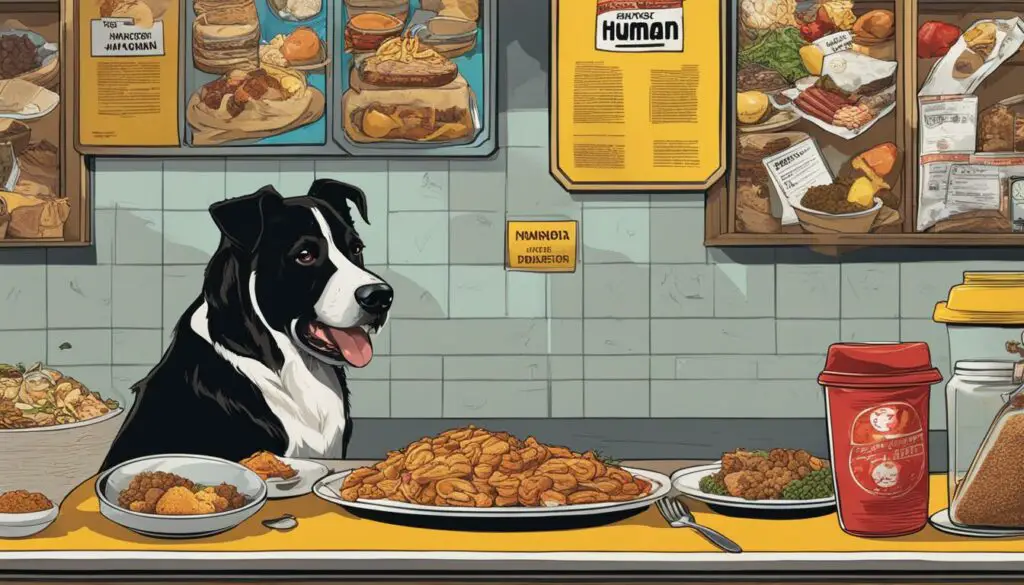
Don’t believe everything you hear
“One common myth is about apple cores and seeds. While it’s important to remove the cores and seeds to prevent any potential poisoning, eating a few apple seeds is unlikely to cause harm to dogs.”
When it comes to feeding dogs, there are many misconceptions about which human foods are safe or harmful. It’s important to separate fact from fiction to ensure the health and well-being of our furry friends. Contrary to popular belief, apple cores and seeds in small quantities do not pose a significant risk to dogs. While it’s important to remove the cores and seeds to prevent any potential poisoning, eating a few apple seeds is unlikely to cause harm. However, it’s always best to err on the side of caution and avoid feeding apple seeds to dogs to ensure their safety.
The same goes for pork. Many people believe that pork is dangerous for dogs, but cooked pork without seasonings can be a safe and nutritious treat for them. Just make sure to remove any excess fat or bones before feeding it to your dog. Similarly, grains are often misunderstood. While some dogs may have allergies or sensitivities to grains, they are not inherently harmful. In fact, grains can provide valuable nutrients and fiber to a dog’s diet, as long as they are not sensitive to them. It’s important to consult with a veterinarian to determine if grains are suitable for your dog’s specific dietary needs.
By debunking these misconceptions and providing accurate information, we can make informed decisions about the foods we feed our dogs. Remember, when in doubt, always consult with a veterinarian to ensure that the foods you are feeding your dog are safe and appropriate for their individual needs.
Foods to Avoid During the Holidays
During the holiday season, it’s important to be mindful of the foods you feed your pets. While it can be tempting to share the joy of festive meals with our furry friends, it’s crucial to remember that some holiday foods can be harmful to animals and may upset their stomachs. To ensure the well-being of your pets, it’s best to avoid feeding them certain holiday foods that can pose risks to their health.
The Dangers of Feeding Pets Holiday Foods
One common holiday food to avoid feeding pets is fatty meats, such as ham. These meats can be difficult for pets to digest and may lead to digestive issues. Additionally, holiday desserts like pumpkin pie, sugar cookies, and gingerbread can contain high levels of sugar, spices, and fillers that can be harmful to your pet’s digestive system. It’s best to refrain from feeding these foods to your pets to prevent any potential complications.
To ensure the safety and well-being of your pets during the holiday season, it’s important to stick to pet-safe alternatives. By providing your pets with suitable options, you can still include them in the festive spirit while keeping them healthy and happy.
Table: Holiday Foods to Avoid Feeding Pets
| Foods to Avoid | Reasons to Avoid |
|---|---|
| Fatty Meats (e.g., Ham) | Difficult to digest and may cause digestive issues |
| Holiday Desserts (e.g., Pumpkin Pie, Sugar Cookies) | High in sugar, spices, and fillers that can be harmful to pets |
By prioritizing the well-being of your pets and avoiding feeding them certain holiday foods, you can enjoy a festive season together while ensuring their health and happiness. Remember, it’s always better to stick to pet-safe alternatives and consult with your veterinarian if you have any concerns about your pet’s diet during the holidays.
Pet-Safe Alternatives for Holiday Foods
When it comes to the holiday season, we all want to include our furry friends in the festivities. However, it’s important to be mindful of the foods we feed them. Instead of sharing traditional holiday dishes that may upset their stomachs, consider offering pet-safe alternatives that are both delicious and nutritious.
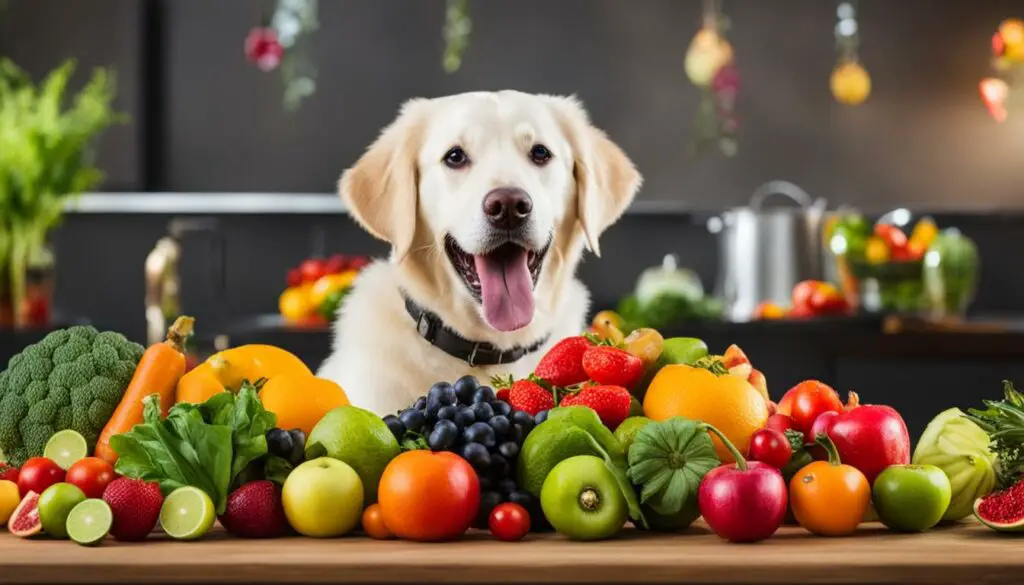
H3: Pet-Friendly Desserts
We all love indulging in sweet treats during the holidays, and your pets can too! Instead of sharing sugary desserts that can be harmful to their digestive system, opt for pet-friendly alternatives like homemade treats made with pet-safe ingredients. For example, you can prepare a batch of peanut butter and pumpkin dog cookies or freeze some yogurt and fruit popsicles for your pets to enjoy. These desserts are not only safe for them, but they also provide a refreshing and delicious way to beat the holiday heat.
H3: Festive Feasting
While it can be tempting to share your holiday feast with your pets, it’s important to remember that certain foods can be harmful to them. Instead of offering them fatty meats like ham, opt for small lean cuts of cooked meat without seasoning. You can also provide them with plain baked or broiled potatoes as a tasty and safe treat. Avoid feeding them mashed potatoes with gravy or other toppings that may upset their stomachs. By choosing pet-safe alternatives, you can ensure that your pets can partake in the holiday feast without any health risks.
H3: Healthy Snacking
In addition to desserts and festive feasting, you can also offer your pets healthy snacks during the holidays. Fruits and vegetables like apples, carrots, and green beans make excellent treats for dogs and cats. Just make sure to remove any seeds or cores from the fruits as they can be harmful. You can also provide them with pet-friendly chew toys or dental treats to keep their teeth clean and satisfy their natural urge to chew.
By choosing pet-safe alternatives for holiday foods, you can ensure that your furry friends can join in on the holiday fun without compromising their health. Remember to consult with your veterinarian for specific dietary recommendations and to ensure that the ingredients you use are safe for your pets. With a little creativity and consideration, you can make this holiday season enjoyable for both you and your beloved pets.
The Benefits of Raw Bones for Dogs
Dogs have a natural instinct to chew, and providing them with raw bones can offer several benefits. Raw bones promote healthy chewing habits, exercise their jaws, and help clean their teeth. Chewing on raw bones can also satisfy their urge to chew and keep them mentally stimulated. Additionally, raw bones provide essential nutrients, such as calcium, which is crucial for bone health and development.
Raw bones also serve as a natural and safe alternative to other chew toys or treats that may contain artificial ingredients or additives. They are a healthier option that supports a dog’s natural diet and can contribute to their overall well-being. However, it’s important to choose the right size raw bone for your dog to prevent choking hazards or tooth breakage. Always supervise your dog while they are chewing on a raw bone to ensure their safety.
Table: Nutritional Advantages of Raw Bones
| Benefit | Explanation |
|---|---|
| Calcium | Raw bones are a natural source of calcium, which is essential for bone health and development. |
| Dental Health | Chewing on raw bones can help remove plaque and tartar, promoting healthy teeth and gums. |
| Mental Stimulation | Chewing on raw bones keeps dogs mentally engaged and provides a constructive outlet for their energy. |
| Exercise | The act of chewing on raw bones supports jaw strength and provides physical exercise. |
Chewing on raw bones is a natural behavior for dogs. Not only does it provide them with numerous health benefits, but it can also prevent destructive behaviors such as chewing on furniture or shoes. Raw bones promote dental health, exercise their jaws, and provide mental stimulation. Just be sure to choose the right size bone and supervise your dog to ensure their safety.
Incorporating raw bones into your dog’s diet can be a great way to promote their overall health and well-being. However, it’s essential to consult with your veterinarian to determine the appropriate type and size of bones for your dog, especially if they have any existing health conditions or dietary restrictions. By providing your dog with the benefits of raw bones in a responsible manner, you can support their natural instincts and contribute to their long-term vitality.
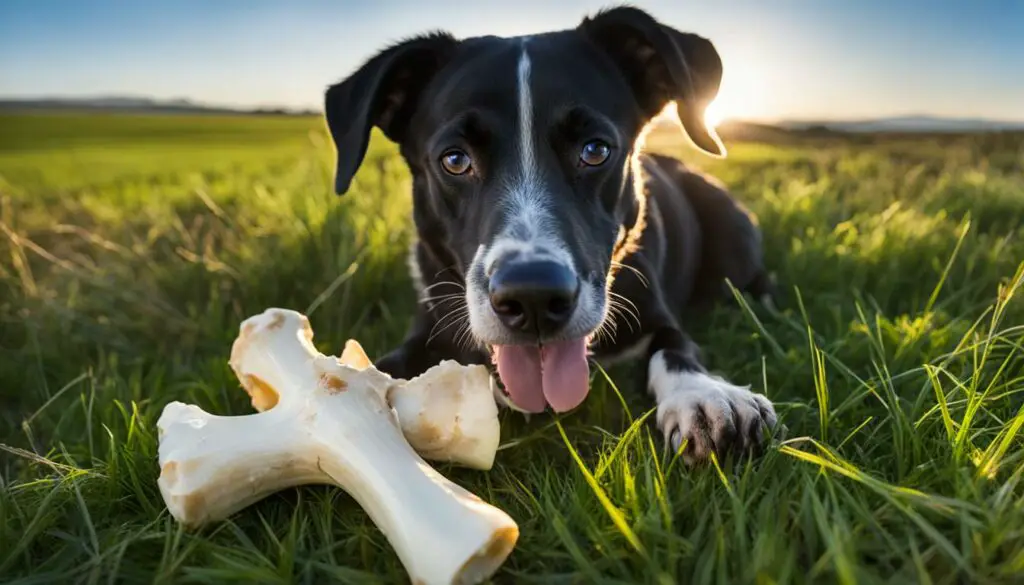
Debunking Myths About Feeding Raw Bones to Dogs
Feeding raw bones to dogs has been a topic of debate among pet owners, with various myths and misconceptions surrounding the practice. Here, I will debunk some of the common myths and provide accurate information to help you make informed decisions for your furry friend.
- Myth: Raw bones make dogs aggressive. This is a commonly believed myth, but possessiveness over high-value items like bones is often just resource-guarding behavior. It’s important to establish boundaries and train your dog to understand that bones are not to be guarded aggressively.
- Myth: Cooked bones are safer than raw bones. Contrary to popular belief, cooked bones can actually be more dangerous for dogs. When bones are cooked, they become brittle and prone to splintering, increasing the risk of injury to your dog’s digestive system or choking hazards.
- Myth: Raw bones cause injuries in dogs. While it’s true that any bone can pose a risk of injury, when given in the proper size and under supervision, raw bones can be enjoyed safely by dogs. It’s important to choose bones that are appropriate for your dog’s size and chewing habits to minimize the risk of any injuries.
- Myth: Raw bones harbor harmful bacteria. It’s true that raw bones can carry bacteria like Salmonella, but the risk can be minimized by selecting high-quality, ethically sourced raw bones. Handle raw bones with proper hygiene practices and ensure your dog’s environment remains clean to prevent any potential bacterial contamination.
“Understanding the facts and debunking these myths is essential for responsible pet owners. By providing appropriate raw bones and following guidelines for safe feeding, you can offer your dog a enjoyable chewing experience while minimizing any potential risks.” – Veterinary Nutritionist
Remember, it’s always a good idea to consult with a veterinarian to ensure that feeding raw bones aligns with your dog’s specific needs and health conditions. Together with proper nutrition and responsible pet parenting, you can provide your furry companion with a safe and enjoyable raw bone experience.
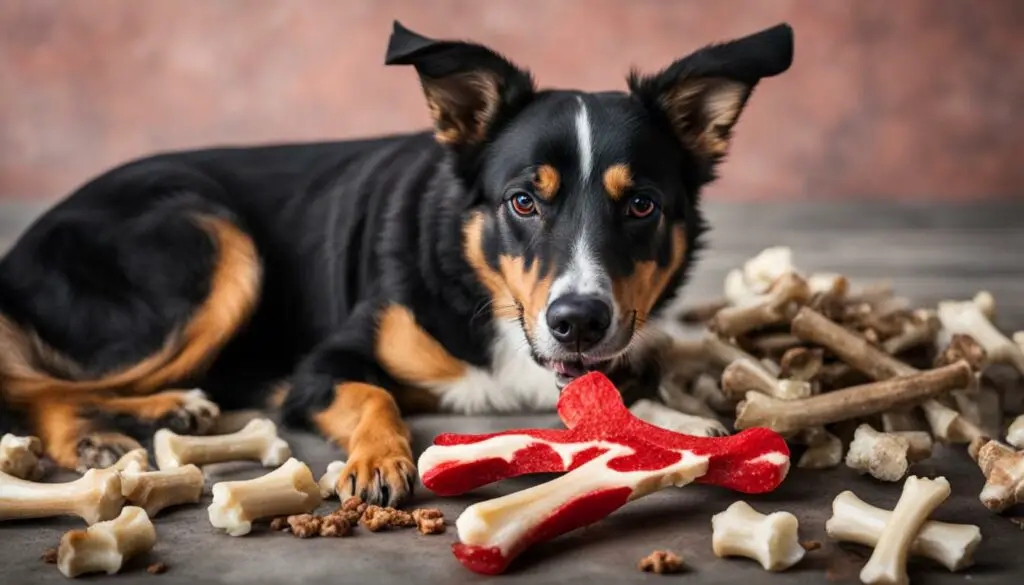
Ensuring Safety When Feeding Raw Bones
Feeding raw bones can provide several benefits for dogs, including promoting dental health, satisfying their natural urge to chew, and providing essential nutrients like calcium. However, it’s crucial to prioritize safety when feeding raw bones to ensure the well-being of your furry friend.
One important aspect of ensuring safety is choosing the proper bone size for your dog. Bones that are too small can pose a choking hazard, while bones that are too large can lead to tooth breakage. It’s best to consult with your veterinarian to determine the appropriate bone size based on your dog’s breed, size, and chewing habits.
In addition to proper bone sizing, it’s essential to handle raw bones safely. Raw bones can contain harmful bacteria such as Salmonella, so it’s important to practice good hygiene and prevent bacterial contamination. You can store raw bones in airtight containers or resealable bags in the freezer to maintain their freshness and minimize the risk of bacterial growth.
By prioritizing safety and following these guidelines for feeding raw bones, you can provide your dog with a satisfying chewing experience while minimizing the risk of choking hazards, tooth breakage, and bacterial contamination.

Benefits of Ensuring Safety When Feeding Raw Bones:
- Promotes dental health by naturally cleaning teeth and preventing plaque buildup.
- Satisfies a dog’s natural urge to chew, reducing destructive behavior and promoting mental stimulation.
- Provides essential nutrients like calcium for healthy bone development.
- Minimizes the risk of choking hazards, tooth breakage, and digestive issues.
- Prevents bacterial contamination and reduces the risk of foodborne illnesses.
By ensuring safety when feeding raw bones, you can enjoy the many benefits they offer while keeping your dog happy, healthy, and safe.
Raw Bones for Puppies and Kittens
Puppies and kittens can benefit from the inclusion of raw bones in their diet. Raw bones provide essential calcium during their growth phases, which is crucial for proper bone development. Calcium plays a vital role in bone formation and strength, ensuring that young pets develop healthy skeletal structures. By incorporating raw bones into their diet, pet owners can help support their puppies‘ and kittens’ bone health.
In addition to calcium, raw bones offer other nutritional advantages for young pets. They provide natural sources of protein and certain vitamins and minerals, contributing to a balanced diet. Chewing on raw bones also aids in the development of proper chewing habits and encourages good dental hygiene. The act of gnawing on bones helps remove plaque and tartar from their teeth, reducing the risk of dental issues later in life.
When introducing raw bones to puppies and kittens, it’s essential to choose bones that are appropriately sized for their age and breed. Larger bones can be challenging for young pets to handle, potentially causing injuries or discomfort. It’s also important to supervise their chewing sessions to ensure they are chewing safely and not biting off large chunks of bone. By following these guidelines, pet owners can provide their puppies and kittens with the benefits of raw bones while minimizing any potential risks.
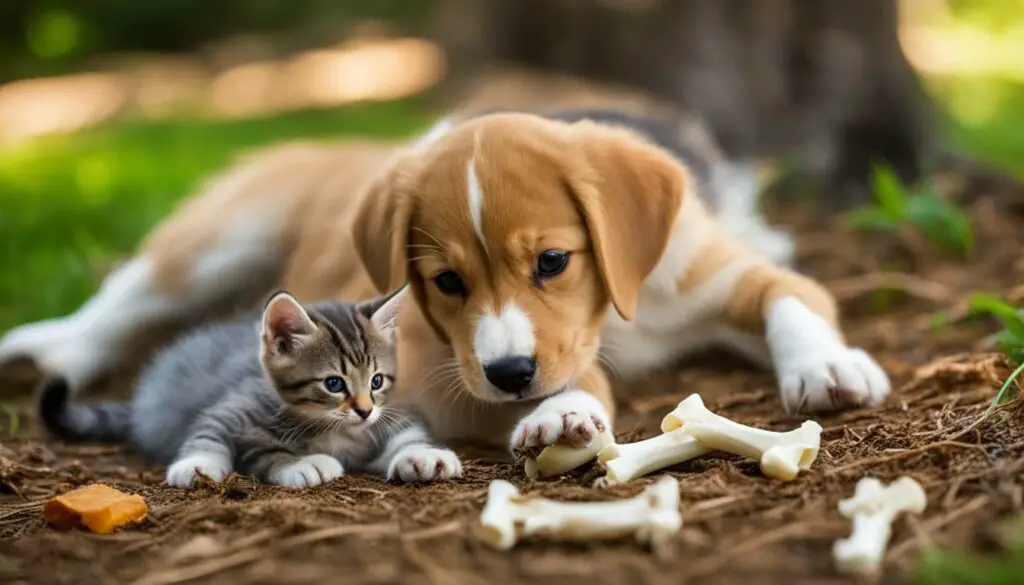
The Benefits of Raw Bones for Young Pets:
- Essential calcium for proper bone development.
- Natural sources of protein, vitamins, and minerals.
- Promote healthy chewing habits.
- Contribute to good dental hygiene.
Responsible Pet Parenting with Raw Bones
As pet owners, it’s our responsibility to ensure the safety and well-being of our furry friends. When it comes to feeding raw bones to dogs, it’s essential to understand their behavior and needs to make informed decisions. Dogs may exhibit possessiveness over bones, which should be addressed responsibly. It’s important to observe your pet’s behavior and preferences to choose the right-sized bones that are safe for them to chew on.
Choosing the right-sized bones for your dog is crucial to prevent choking hazards or tooth breakage. Each dog is unique, and their size, breed, and chewing habits should be taken into consideration. Larger dogs may require larger bones, while smaller dogs may need smaller ones. By providing appropriately sized bones, you can ensure a safe and enjoyable chewing experience for your furry friend.
In addition to choosing the right-sized bones, responsible pet parenting also includes proper handling and hygiene practices. It’s important to handle raw bones safely to prevent bacterial contamination and ensure the health and safety of both your pet and yourself. Invest in airtight containers or resealable bags to store raw bones, preventing bacterial growth and freezer burn. By prioritizing safety and hygiene, you can enjoy the benefits of raw bones while minimizing potential risks.
Understanding Your Pet’s Behavior
Every pet has unique behaviors and preferences when it comes to chewing. Some dogs may be more possessive over their bones, while others may chew more vigorously. It’s essential to observe your pet’s behavior and understand their needs. If you notice any signs of aggression or resource guarding behavior, it’s important to address it responsibly. Seek guidance from a professional dog trainer or behaviorist to ensure a harmonious and safe environment for both you and your pet.
By being responsible pet parents and considering our pet’s behavior, needs, and safety, we can provide them with a happy and fulfilling life. Choosing the right-sized bones and practicing proper handling and hygiene ensures that our pets can enjoy the benefits of raw bones without compromising their well-being. When it comes to raw bones, remember to prioritize safety, observe your pet’s behavior, and consult with professionals if needed. With responsible pet parenting, we can create a loving and nurturing environment for our furry companions.
Quality Matters: Choosing Safe Raw Bones
Choosing safe raw bones is crucial to ensure the health and well-being of your furry friend. When it comes to feeding your dog raw bones, the quality of the bones matters. Opting for high-quality, human-grade raw bones that are ethically sourced minimizes the risk of harmful bacterial contamination like Salmonella. Just as you prioritize safe food handling for yourself, extend the same care to your pet’s raw bones. Investing in airtight containers or resealable bags can help prevent bacterial contamination and freezer burn, ensuring the bones remain fresh and safe for your dog to enjoy.
When selecting raw bones for your dog, it’s important to consider the source. Look for suppliers or brands that prioritize transparency and provide information about their sourcing practices. Ethically sourced raw bones come from animals that have been humanely raised and do not contain any added hormones or antibiotics. By choosing bones from reputable sources, you can have peace of mind knowing that you are offering your dog safe and high-quality bones.
Additionally, proper bone sizing is essential for your dog’s safety. Bones that are too small can pose a choking hazard, while bones that are too large can lead to tooth breakage. It’s crucial to choose a bone that is suitable for your dog’s size and chewing habits. If you’re unsure about the appropriate size, consult with your veterinarian for guidance.
Benefits of Choosing Safe Raw Bones:
- Promotes dental health: Chewing on raw bones can help clean your dog’s teeth and reduce the risk of dental issues such as plaque and tartar buildup.
- Provides mental stimulation: Gnawing on a bone can provide mental stimulation and relieve boredom for your dog.
- Supports healthy chewing habits: Offering safe raw bones can help redirect your dog’s chewing behavior onto an appropriate item, preventing them from chewing on household objects.
- Rich in essential nutrients: Raw bones can provide essential nutrients, including calcium, phosphorus, and trace minerals, which are important for your dog’s overall health and well-being.
By choosing safe raw bones, you can provide your dog with a satisfying chewing experience while minimizing the risk of bacterial contamination and other potential hazards. Remember to always supervise your dog when they are chewing on a bone and discard any bones that become small enough to be a choking hazard. Prioritizing your pet’s safety and well-being is essential in ensuring their long-term health.
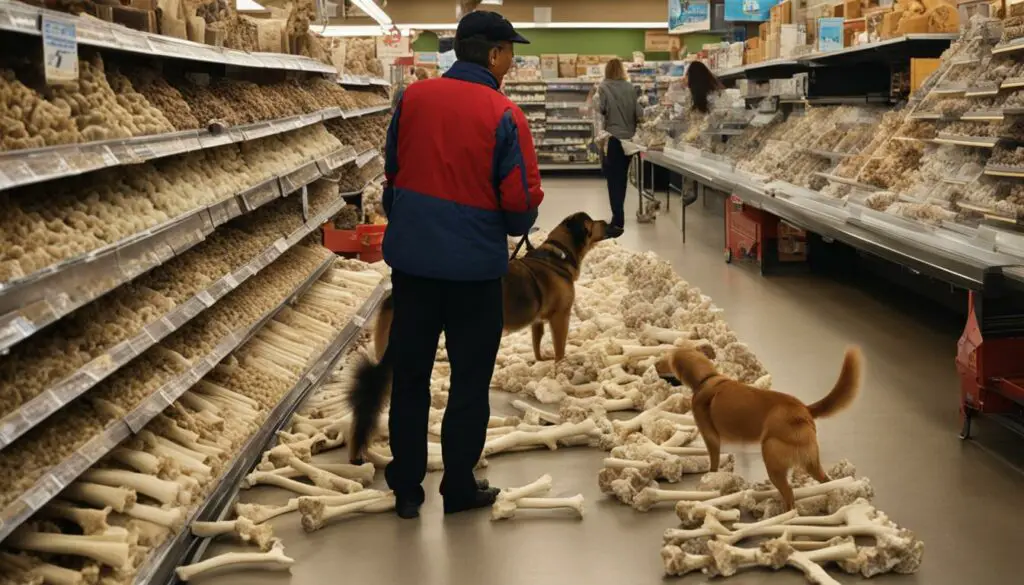
Conclusion
In conclusion, it is not safe for dogs to eat ham bones. These bones can easily splinter, posing a risk of injury to your dog’s digestive system and creating a choking hazard. To ensure the safety of your furry friend, it is important to provide them with alternative bone options that are specifically designed for dogs. These dog-friendly bones are less likely to splinter and can still fulfill your dog’s natural urge to chew.
When it comes to your dog’s nutrition and well-being, it is always best to consult with a veterinarian. They can provide guidance on the proper nutrition for your dog and recommend safe bone options that are suitable for their breed and chewing habits. By prioritizing your pet’s safety and following expert advice, you can ensure that your dog remains healthy and happy.
Remember, while it may be tempting to share certain foods with your dog, it is important to be aware of the potential risks. Always avoid feeding your dog dangerous foods and stick to options that are known to be safe. By being a responsible pet owner and taking care of your dog’s nutritional needs, you can help them live a long, healthy, and happy life.
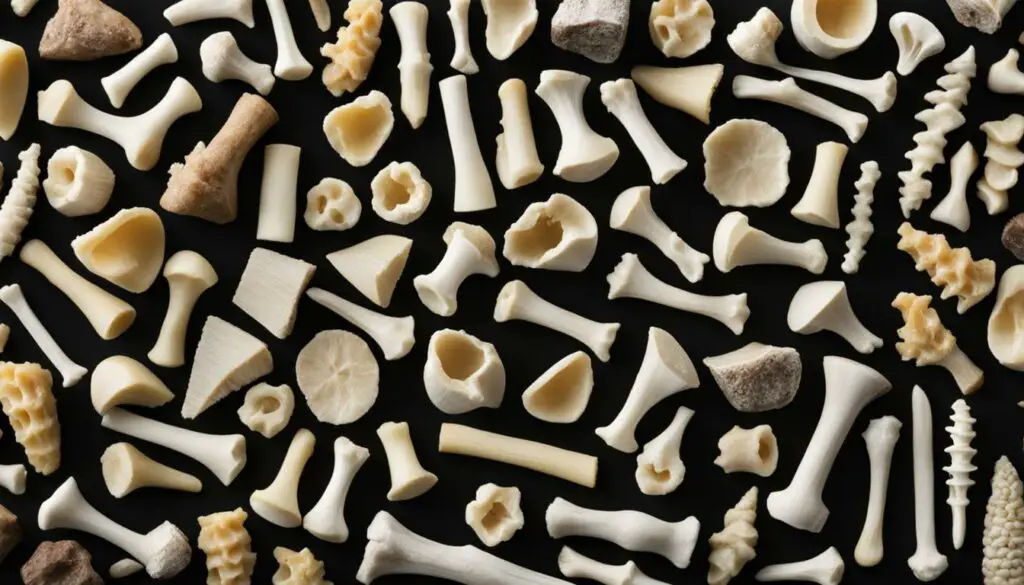
Conclusion
In conclusion, it is not safe to feed ham bones to dogs. Ham bones can splinter easily, posing a risk of injury to their digestive system and creating choking hazards. As responsible pet owners, we should prioritize our dog’s safety and seek out alternative bone options that are designed to be safe for them.
There are dog-friendly bones available in the market that are made of materials less likely to splinter, reducing the risk of harm to our furry friends. These bones come in various sizes, so it’s important to choose the proper bone size based on your dog’s breed and chewing habits.
Understanding our dog’s unique digestive system is essential. Feeding ham bones can lead to digestive issues and blockages that may cause stomach or intestinal problems. By choosing safer alternatives, we can ensure our dogs receive proper nutrition without compromising their health.
So, let’s say no to feeding our dogs ham bones and embrace the numerous dog-friendly bone options available. By doing so, we can provide a satisfying chewing experience for our dogs while ensuring their overall well-being.
FAQ
Can dogs eat ham bones?
No, feeding ham bones to dogs is not recommended due to the potential risks they pose to a dog’s health.
What are the risks of feeding ham bones to dogs?
Ham bones can splinter easily and pose various risks to a dog’s health, such as choking hazards and digestive issues.
Why should I avoid feeding ham bones to my dog?
Ham bones can splinter easily and cause harm to a dog’s digestive system. It’s safer to choose dog-friendly bone options.
What are some alternatives to feeding ham bones?
There are many dog-friendly bone options available that are specifically designed to be safe for dogs to chew on.
How can I ensure the safety of my dog when feeding bones?
It’s important to choose bones that are appropriate in size and follow guidelines for supervision to prevent any potential hazards.
Are there any misconceptions about certain human foods for dogs?
Yes, there are misconceptions about foods like apple cores and seeds, pork, and grains, which can be safe for dogs when fed properly.
What foods should I avoid feeding my pet during the holidays?
It’s best to avoid feeding pets fatty meats like ham and holiday desserts that are loaded with sugar, spices, and fillers.
Are there pet-safe alternatives for holiday foods?
Yes, you can offer small lean cuts of meat and plain baked or broiled potatoes as safer options for your pets during the holidays.
What are the benefits of feeding raw bones to dogs?
Raw bones provide a natural way for dogs to exercise their jaws, clean their teeth, and satisfy their urge to chew.
What are some common myths about feeding raw bones to dogs?
There are myths about raw bones making dogs aggressive and cooked bones being safer, but these are not true.
How can I ensure the safety of my dog when feeding raw bones?
Proper bone sizing and safe handling are essential to prevent choking hazards, tooth breakage, and bacterial contamination.
Can puppies and kittens eat raw bones?
Yes, raw bones can be beneficial for puppies and kittens as they provide essential calcium and promote healthy chewing habits.
How can I be a responsible pet parent with raw bones?
By observing your pet’s behavior and preferences, choosing the right-sized bones, and practicing safe handling and hygiene.
Does the quality of raw bones matter?
Yes, opting for high-quality, human-grade raw bones that are ethically sourced minimizes the risk of harmful bacteria.
Can I feed my dog cooked bones instead of raw bones?
No, cooked bones can splinter and pose a significant risk to dogs. It’s best to stick to raw bones that are safer.
What is the conclusion about feeding ham bones to dogs?
Feeding ham bones to dogs is not recommended due to the potential risks they pose. It’s safer to provide dog-friendly bone alternatives.
What is the overall conclusion?
It’s important to prioritize the safety and well-being of your dog by choosing safe bone options and consulting with a veterinarian for proper nutrition guidance.

